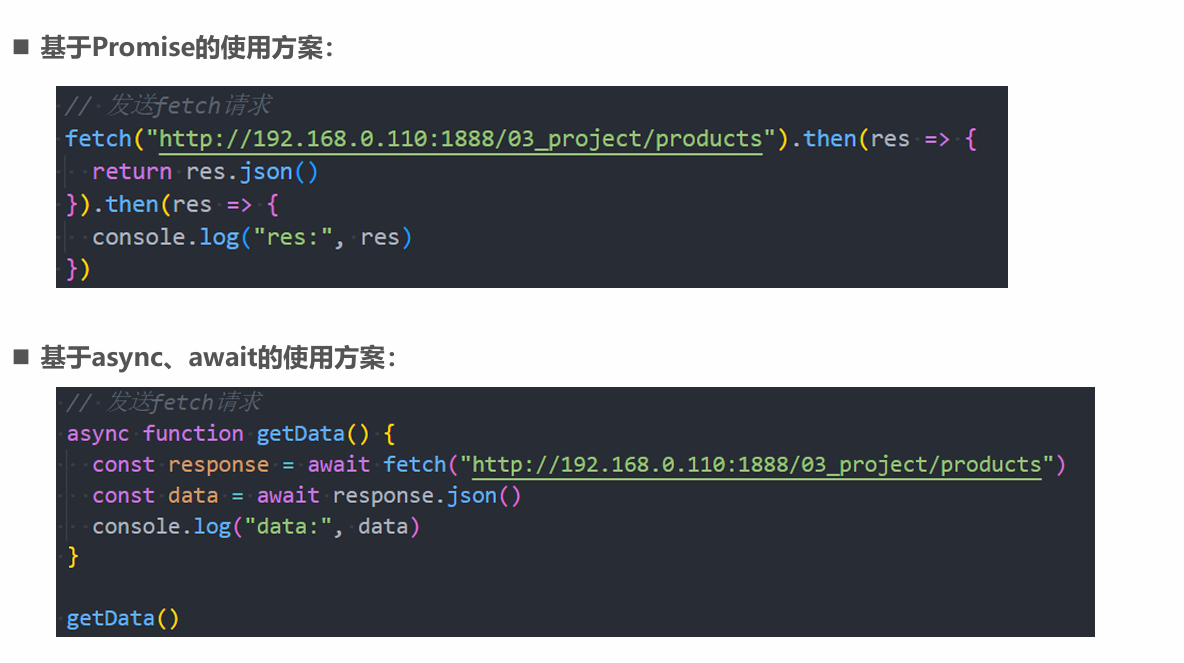Fetch和Fetch API
认识Fetch和Fetch API
◼ Fetch可以看做是早期的XMLHttpRequest的替代方案,它提供了一种更加现代的处理方案:
比如返回值是一个Promise,提供了一种更加优雅的处理结果方式
✓ 在请求发送成功时,调用resolve回调then;
✓ 在请求发送失败时,调用reject回调catch;
比如不像XMLHttpRequest一样,所有的操作都在一个对象上;
◼ fetch函数的使用:

input:定义要获取的资源地址,可以是一个URL字符串,也可以使用一个Request对象(实验性特性)类型;
init:其他初始化参数
✓ method: 请求使用的方法,如 GET、POST;
✓ headers: 请求的头信息;
✓ body: 请求的 body 信息;
Fetch数据的响应(Response)
◼ Fetch的数据响应主要分为两个阶段:
◼ 阶段一:当服务器返回了响应(response)
fetch 返回的promise 就使用内建的Response class 对象来对响应头进行解析;
在这个阶段,我们可以通过检查响应头,来检查HTTP 状态以确定请求是否成功;
如果fetch 无法建立一个HTTP 请求,例如网络问题,亦或是请求的网址不存在,那么promise 就会reject;
异常的HTTP 状态,例如404 或500,不会导致出现error;
◼ 我们可以在response 的属性中看到HTTP 状态:
status:HTTP 状态码,例如200;
ok:布尔值,如果HTTP 状态码为200-299,则为true;
◼ 第二阶段,为了获取response body,我们需要使用一个其他的方法调用。
response.text() —— 读取 response,并以文本形式返回 response;
response.json() —— 将 response 解析为 JSON;
script>
//1.fetch发起get请求
// fetch("http://123.207.32.32:8000/home/multidata").then(res=>{
//1.获取到对应的response
//2.获取具体结果
// 1.1未优化
// res.json().then(res=>{
// console.log(res)
// })
// }).catch(err=>{
// console.log(err)
// })
// 优化方式一
// return res.json()
// }).then(res=>{
// console.log(res)
// }).catch(err=>{
// console.log(err)
// })
// 优化方式二:
// async function getDate() {
// const response = await fetch("http://123.207.32.32:8000/home/multidata")
// const res = await response.json()
// console.log(res)
// }
// getDate()
// 2.post请求有参数
async function getDate() {
const formData = new FormData()
formData.append("name","hdc")
formData.append("age",21)
const response = await fetch("http://123.207.32.32:1888/02_param/postform",{
method:"post",
body:formData
})
// 获取response状态
console.log(response.ok,response.status,response.statusText)
const res = await response.json()
console.log(res)
}
getDate()
</script>
Fetch网络请求的演练

Fetch POST请求





